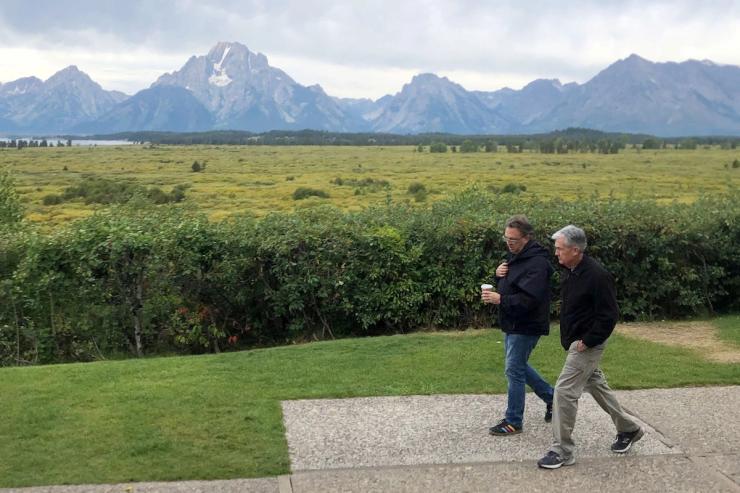When you are hiking up or down a mountain and the terrain is rough, it’s best to take small steps to keep your balance and footing. That’s likely how Jerome Powell is going to handle his valedictory speech in Jackson Hole, Wyoming this week as Federal Reserve Chairman: Take small, careful steps, and avoid falling.
Powell, now in his eighth and final year as the central bank leader, has handled his share of crises. The elements are again coming at him from every side: Inflation is stuck above the central bank’s 2% target, the job market shows signs of cracking, dissent is building inside the institution about how to respond, and President Donald Trump and his advisers are attacking the Fed on a routine basis, pushing for new leadership and much lower interest rates. That’s the backdrop for his keynote speech Friday at the Fed’s Jackson Hole symposium, where global central bank leaders meet every year.
Most of his comments will focus on an important but somewhat obscure matter that has been in the works for months. The Fed has been undertaking a review of its roadmap document, last updated in 2020, in which it defines what it is trying to accomplish and how. He will preview updates Friday. The Fed’s two main goals — keeping inflation steady and ensuring as many Americans as possible have jobs — are now in some conflict, with job growth slowing and inflation still higher than the Fed would like.
Powell will reaffirm a commitment to that 2% inflation goal, which is somewhat odd given that it has exceeded that target for 53 straight months. If the Fed were recommitting to bringing that down, it might consider raising interest rates to slow borrowing and demand. Instead, Powell is likely to open a door to a small interest rate cut in his comments Friday.
Why? It’s because of the labor market. When officials last met in July, the job market still looked solid to most of them. Unemployment was low and private payrolls were rising. Then in early August, the Bureau of Labor Statistics reported large downward revisions to its estimates of payroll growth in May and June, and another month of soft hiring in July. The jobless rate also ticked up. The revisions outraged Trump, who promptly fired the commissioner of the BLS.
For Powell, the report created a different kind of problem: How can he keep the Fed’s benchmark interest rate at 4.3% when a job downturn potentially looms? A rate cut might help to keep the economy humming. If, on the other hand, he stays put, Powell could become the object of blame for stoking a recession. That blame might be unfair; Trump’s tariffs and a national immigration crackdown, which are surely affecting demand and hiring, aren’t Powell’s doing. But an argument of “not my fault” isn’t the legacy-defining epilogue he’s after.
Investors are nearly certain Powell will cut the fed funds rate by a quarter percentage point in September to a little over 4%. Futures markets point to successive quarter-point rate cuts in October and December. Trump and his advisers want the Fed to be even more aggressive.
Powell will likely give them a little of what they want in Jackson Hole — an acknowledgement of a softening labor market and thus the possibility of a rate cut next month. But he’s not going to encourage anyone to expect a lot more from him beyond that, yet.
In the parlance of central banking: The Powell Fed will keep making decisions on a meeting-by-meeting basis, and it will take its cues from the numbers. That means if inflation moves much higher, the 2025 rate-cut party could end not long after it starts.
The Fed risks making a mistake. Many Fed officials believe that a 4.3% interest rate is “restrictive” — meaning it constrains the economy. Yet financial markets and inflation aren’t behaving as if they’re constrained at these interest rate levels. Inflation’s descent has stopped above 2% before tariffs hit, stock prices are rising, risky borrowers are finding money cheap, crypto assets are booming, and bank lending is up. Lower rates would only add fuel to that fire.
Powell had been hoping for a cleaner economic path toward his exit as chairman next year. But he’s not going to get off this mountain without navigating a few more treacherous patches before he leaves.
Jon Hilsenrath is a former senior writer for The Wall Street Journal, where he specialized in economics and finance, serving as economics editor, markets editor, and chief economics correspondent. He’s the author of “Yellen,” a biography of the Treasury Secretary and former Federal Reserve Chairwoman, which The Economist called “elegant and erudite.” Hilsenrath was a Pulitzer Prize finalist in 2014 for his Federal Reserve coverage and in 2009 for financial crisis reporter. His on-the-scene reporting of 9/11 contributed to The Wall Street Journal’s Pulitzer Prize-winning coverage in 2002.


